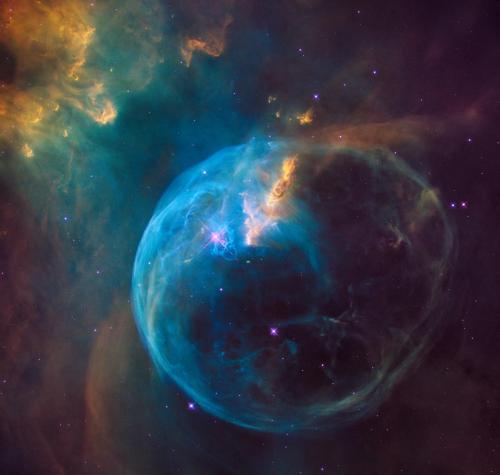Bubble Nebula - Blog Posts

Our universe is FULL of strange and surprising things.
And luckily, our Hubble Space Telescope is there to be our window to the unimaginable! Hubble recently ran into an issue with its payload computer which controls and coordinates science instruments onboard the spacecraft. On July 16, teams successfully switched to backup hardware to compensate for the problem! A day later, the telescope resumed normal science operations. To celebrate, we’re taking you back to 2016 when our dear Hubble captured perhaps one of the most intriguing objects in our Milky Way galaxy: a massive star trapped inside a bubble! The star inside this Bubble Nebula burns a million times brighter than our Sun and produces powerful gaseous outflows that howl at more than four million miles per hour. Based on the rate the star is expending energy, scientists estimate in 10 to 20 million years it will explode as a supernova. And the bubble will succumb to a common fate: It’ll pop.

Our universe is FULL of strange and surprising things.
And luckily, our Hubble Space Telescope is there to be our window to the unimaginable! Hubble recently ran into an issue with its payload computer which controls and coordinates science instruments onboard the spacecraft. On July 16, teams successfully switched to backup hardware to compensate for the problem! A day later, the telescope resumed normal science operations. To celebrate, we’re taking you back to 2016 when our dear Hubble captured perhaps one of the most intriguing objects in our Milky Way galaxy: a massive star trapped inside a bubble! The star inside this Bubble Nebula burns a million times brighter than our Sun and produces powerful gaseous outflows that howl at more than four million miles per hour. Based on the rate the star is expending energy, scientists estimate in 10 to 20 million years it will explode as a supernova. And the bubble will succumb to a common fate: It’ll pop.

Picture of the bubble nebula and surrounding objects : Top left (the vague group of stars): M52 an open cluster
Center right: NGC 7538 an emission nebula (also known as the northern lagoon nebula)
Bottom center: NGC 7635/the bubble nebula and the surrounding hydrogen cloud
The ''bubble'' part of this nebula is created by the stellar wind (flow of gas, plasma and particle) emitted by the central star at nearly 650 million km/h hitting and compressing the surrounding interstellar gas. The central star (BD +602522) is currently estimated to be about 45 times heavier than our sun and about 4 million years old. Being so massive and thus very hot (it's a type O star) its lifespan is very limited for a star and it should go supernova in about 10 to 20 million years.
BD +602522 is slightly off center from the bubble, this is due to the interstellar gas being a bit more dense on one side and thus slowing the stellar wind more efficiently.

Single exposure to make the central star more visible.
Image taken using a CarbonStar 150/600 newtonian telescope with a 0.95 coma corrector, ZWO ASI294 monochrome camera. 12x300s image for each colour filter (LRGB) and 12x300s for the Ha filter, total imaging time 5h, stacking and processing done in PixInsight.
Starless version of the same image:

Older image where the bubble is more distinct from the background hydrogen clouds :


